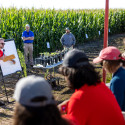Art museum visits help doctors understand feelings

Mariah Quinn (right), assistant professor of medicine and associate program director for the residency in internal medicine, leads her class of medical residents in an exercise at the Chazen Museum of Art.
Photo: Clint Thayer
Though often perceived as omnipotent healers, doctors are merely — and importantly — human. At the UW–Madison School of Medicine and Public Health, Mariah Quinn uses art to help medical residents reflect on their professional identities, emotions and cognitive processes.
“Medical education is evolving to help physicians understand how to listen to and manage their own thoughts and feelings,” says Quinn, director of humanism in medicine for the Department of Medicine. “I like to utilize art and the museum environment to provoke medical residents to approach thoughts and feelings that might be difficult to access otherwise.”
Art in a hospital helps humanize a clinical environment during a time of uncertainty and fear. Some studies show how it can help patients heal faster.
In Quinn’s course “Communication and Humanism in Medicine,” bringing medical residents to UW–Madison’s Chazen Museum of Art helps them develop skills and explore the emotional side of their work. They’ll take these skills back to a patient’s bedside.

Mariah Quinn
“The art objects and the museum environment contribute to our ability to look at themes like vulnerability, uncertainty, caring for dying patients, and bias with more courage,” says Quinn. “In this environment, they don’t have to fear making mistakes; they can take risks. We discuss topics that can be very uncomfortable and provocative for many people.”
The SMPH designed these classes to help residents develop professional identity and relationship skills. Jordan Kenik is taking Quinn’s course during his first year as a resident in internal medicine.
“I was surprised at how comfortable we all felt exploring our biases in the setting of analyzing the art,” says Kenik. “Somehow the process of dissecting a piece of art made me feel totally free to say exactly what was on my mind.”
In order to provoke a response from the residents, Quinn sets up the environment by working with Anne Lambert, curator of education at the Chazen.
“The residents spend time concentrating on an artwork, often picked because it illustrates human emotions and circumstances, some of them provocative or uncomfortable,” says Lambert. “These young doctors come across vastly different artworks from which they must make sense, hone a vocabulary, and develop empathy — not unlike a hospital, where they may encounter a patient and family circumstances without prior context.”
“These young doctors come across vastly different artworks from which they must make sense, hone a vocabulary, and develop empathy — not unlike a hospital, where they may encounter a patient and family circumstances without prior context.”
Anne Lambert
Kenik and several fellow residents spent a recent Chazen visit working through implicit bias: a positive or negative mental attitude towards a person, thing, or group that an individual holds at an unconscious level. Using art to reflect on their practices, residents can share examples and perspectives with colleagues to better understand how their own biases may affect their relationships with patients.
“Through these discussions, we develop a shared understanding of strategies for counteracting bias,” says Quinn. “For instance, research shows that racial minorities receive a variety of treatments, from pain management to cardiac catheterizations, at different rates, and that some of this variation is rooted in physician bias.”
In another session, Quinn uses art to help residents reflect on some of the more emotional parts of their work, such as caring for patients who are dying or in pain.
“Sometimes physicians become isolated with their feelings,” says Quinn. “They may struggle with helping patients in pain or whose care may seem futile. Some carry the grief they experience from families and loved ones, or their own grief at the loss of a patient. Many experience emotional exhaustion. What they often find is a huge sense of relief when they hear their own thoughts and feelings being echoed by others.”
Evidence is mounting that physicians who are dissatisfied, burned out or depressed do not provide the same quality of care as their happier colleagues. By becoming familiar with their own emotional side, these doctors gain better tools to understand their patients and themselves.
Thanks to their time in the Chazen, a walk through an art museum could be just what the doctor ordered.




